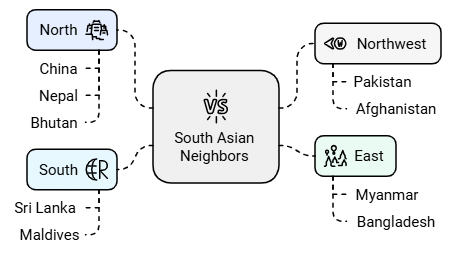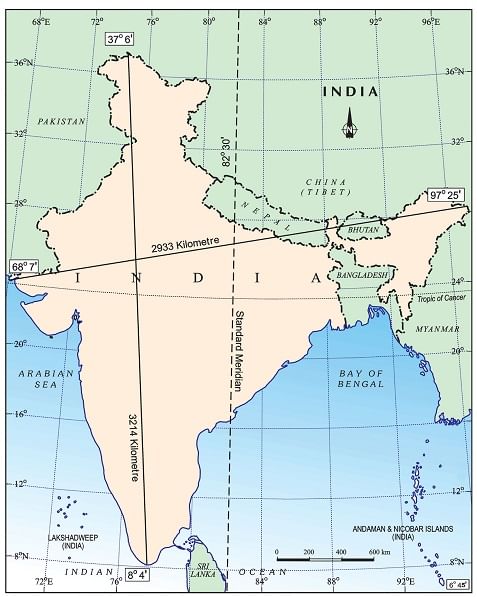UPSC Exam > UPSC Notes > NCERT Video Summary: Class 6 to Class 12 (English) > NCERT Summary: India - Size & Location
India - Size & Location Summary Class 9 Social Science Chapter 1
Introduction
India is one of the oldest civilisations and have a remarkable history. After Independence from British rule, it achieved multi-faceted socio-economic progress. Also made a remarkable progress in the field of agriculture, industry, technology and overall economic development.
India's Location
- Lies entirely in Northern hemisphere between latitudes 8°4' N and 37°6' N and longitudes 68°7' E and 97°25' E.
- Divided by Tropic of cancer (23°30' N) in almost two equal parts.
- In Southeast, Andaman and Nicobar islands lie in Bay of Bengal.
- In Southwest, Lakshadweep islands lie in Arabian Sea.
Its Size
- Total Area of India is 3.28 million square km which is 2.4 percent of the total area of the world.
- It is seventh largest country in the world in terms of landmass.
- It has land boundary of about 15,200 km and the total length of the coast line of the mainland including Andaman and Nicobar and Lakshadweep islands is 7,516.6 km.
- In the northwest, north and north east of India, young folds mountains bounds it.
- South of about 22° north latitude, India narrows and finally extends towards the Indian Ocean. It also divides it into two seas, the Arabian Sea on the west and the Bay of Bengal on its east.
- The latitudinal and longitudinal extent of the mainland is about 30°.
- India’s east-west extent appears to be smaller than the north-south extent.
- The time along the Standard Meridian (82°30' E) passing through Mirzapur in UP is taken as the Indian Standard Time for whole country.
- The time gap between Arunachal Pradesh present in the east and Gujarat present in the west is about 2 hours. The latitudinal extent influences the duration of day and night, as one moves from south to north.
[Question: 890729]
India and the World
- India is located in the centre of the World between East and the West Asia.
- The routes across the Indian ocean which connect the countries of Europe in the West and the countries of East Asia provide a strategic central location to India.
- The Deccan Peninsula helps India to establish close contact with West Asia, Africa and Europe from the western coast and with Southeast and East Asia from the eastern coast.
- The Ocean which is south of India given name Indian Ocean as no other country has a long coastline on the Indian Ocean as India has.
- The land routes of India are much older than sea route. Various passes across mountains in the north have provided passages to the ancient travellers as ocean limited such interaction for a long time.
- The land routes helped India in the exchange of ideas and commodities since ancient times.
- India have propagated the ideas of the Upanishads and the Ramayana, the stories of Panchtantra, the Indian numerals and the decimal system as well as given spices, muslin and other merchandise to different countries.
- Also, the influence of Greek sculpture, and the architectural styles of dome and minarets from West Asia can be seen in different parts of India.
Its Neighbours
India is comprised of 28 states and 8 union territories and shares its land boundary with:
Sri Lanka is separated from India by a narrow channel of sea formed by the Palk Strait and the Gulf of Mannar
Maldives Islands are situated to the south of the Lakshadweep Islands.
A peninsula is a piece of land that is bordered by water on three sides but connected to mainland on one side.
Important Map
The document India - Size & Location Summary Class 9 Social Science Chapter 1 is a part of the UPSC Course NCERT Video Summary: Class 6 to Class 12 (English).
All you need of UPSC at this link: UPSC
|
493 videos|387 docs
|
FAQs on India - Size & Location Summary Class 9 Social Science Chapter 1
| 1. भारत का आकार और स्थिति क्या हैं? |  |
Ans. भारत का आकार लगभग 3.28 मिलियन वर्ग किलोमीटर है, जो इसे विश्व का सातवां सबसे बड़ा देश बनाता है। यह उत्तरी गोलार्ध में स्थित है और इसका भौगोलिक विस्तार 8°4' उत्तर से 37°6' उत्तर अक्षांश और 68°7' पूर्व से 97°25' पूर्व देशांतर के बीच है।
| 2. भारत की भौगोलिक स्थिति का क्या महत्व है? |  |
Ans. भारत की भौगोलिक स्थिति उसे कई महत्वपूर्ण लाभ देती है, जैसे कि यह एशिया के केंद्र में स्थित है, जिससे यह विभिन्न सांस्कृतिक और व्यापारिक संपर्कों का केंद्र बनता है। इसके अलावा, भारत का क्षेत्रीय विस्तार विभिन्न जलवायु परिस्थितियों और प्राकृतिक संसाधनों का भी धारण करता है।
| 3. भारत की सीमाएं किन देशों से मिलती हैं? |  |
Ans. भारत की सीमाएं पाकिस्तान, चीन, नेपाल, भूटान, बांग्लादेश, और म्यांमार से मिलती हैं। इसके अलावा, भारत का समुद्री किनारा भी श्रीलंका और मालदीव के निकट है, जो इसे रणनीतिक दृष्टि से महत्वपूर्ण बनाता है।
| 4. भारत का मानचित्र कैसे समझा जाए? |  |
Ans. भारत के मानचित्र को समझने के लिए, पहले इसके प्रमुख नदियों, पर्वत श्रृंखलाओं, और पठारों का ध्यान रखना आवश्यक है। इसके अलावा, राज्यों और केंद्र शासित प्रदेशों की सीमाओं को भी समझना मददगार होता है, जिससे भारत की भौगोलिक विविधता का ज्ञान हो सके।
| 5. भारत का भौगोलिक स्थान किस प्रकार के जलवायु क्षेत्रों को प्रभावित करता है? |  |
Ans. भारत का भौगोलिक स्थान विभिन्न जलवायु क्षेत्रों को प्रभावित करता है, जैसे कि उष्णकटिबंधीय मानसूनी जलवायु, उपोष्णकटिबंधीय जलवायु, और शीतोष्ण जलवायु। इसके कारण, भारत में वर्षा, तापमान, और मौसम की विविधताएं देखने को मिलती हैं, जो कृषि और जीवनशैली पर प्रभाव डालती हैं।
Related Searches

















